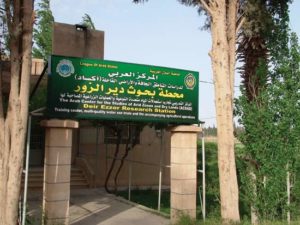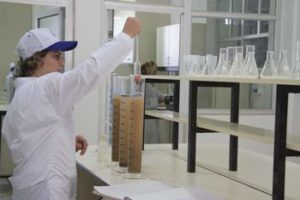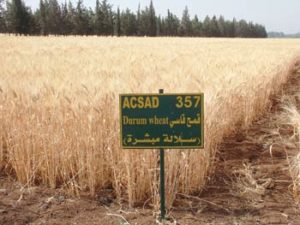Deir-Ezzor Research Station
Site and climate:
It is located in the district of Al-Mreia’aia, about 10 km away from the east of Deir-Ezzor, at an altitude of 203 m above the sea.

Its climate is hot and dry in summer, and cold in winter, as the temperature rises during the month of July to reach about 450 and falls during the months of December and January to minus zero. Its wind is western in general, and sandy eastern sometimes. The annual rainfall average is 161 mm.It is located within the modern terrace area of the Euphrates river’s sediments. Most of its soil is poorly-developed and follows the classification of “Typic Calcgypsids and Typic Halocalcids” according to the “USDA Soil Taxonomy”. Its soil ranges between being silty sandy to silty clay with a salinity of 0.9-1.2 m/ds.

Objective:
Achieve the optimal use of soil and water resources and the safe use of saline water in irrigation, and increase the knowledge of human resources in this field.
Infrastructure:
- A well-supplied laboratory for preparing samples and conducting analysis (ECepH% for moisture, mechanical analysis….etc).
- Climate station.

- Concrete tanks for mixing saline water with fresh water.
- Piezometers and supplies for measuring water leakage into soil, irrigation network pressure and soil salinity in the field, in addition to TDR system and metal and sand filters for removing sediments out of the irrigation water.
- Irrigation systems (localized, sprinkle and OSCOP), counters for measuring water discharge and equipment for adding solid and liquid fertilizers.

- Covered drainage network and open drains.
- Gene bank for date palm varieties.
- All necessary supplies and equipment for studies and researches.
- Administrative offices and a training center for 20 trainees.
Activities:
- Study the impact of irrigation water types (fresh, semi-saline and saline) on the physical and chemical soil properties and crop productivity, both in quantity and quality.
- Identify irrigation water efficiency.
- Identify the water requirements of the various crops.
- Study the impact of mineral, organic and biological fertilization on soil fertility and productivity.
- Identify the most appropriate technique packages (agricultural rotation, tillage depth, fertilization and irrigation water) for crop production.
- Study the impact of organic and non-organic enhancers on the physiochemical properties of the soil that is irrigated with saline water.
- Study the impact of the followed irrigation method and fertilizing irrigation on soil chemical properties and fertility and crop productivity.

- Identify the salinity thresholds of crops, fruit trees and some medical and aromatic crops.
- Introduce new salinity-tolerant crops.
- Propagate ACSAD’s wheat and barley varieties and lines.
- Select and evaluate wheat and barley genetic resources for salinity stress-tolerance, temperature stress-tolerance and disease- resistance.
- Conduct agricultural treatment experiments for irrigated wheat varieties.
- Rehabilitate, train and increase the knowledge of Arab technical staffs in the field of optimal land and water uses.




